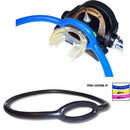1- For standard single tank diving, I use a short hose primary standard length octo hose as octo bungied around my neck.
2- For doubles, my primary is on a 7 foot hose (not wrapped around me, rather routed back and forth between the tank valves held with bungies, so a yank pulls all 7 feet out).
3- For AGA dives (mostly surface supply), my secondary is on a bungee around my neck on a short hose (and I have all sorts of unsightly loops of hose for the AGA, octo, drysuit hose, pnuemofathometer, umbilical, no way around it with a surface supply manifold on my shoulder and a bailout tank on my back). Its my secondary only, I am diving solo.
4- For hard hat dives (always surface supply) I just hope the second stage built into the helmet works, because there's no getting the hat off my head if anything fails Again, bailout bottle, suface umbilical, pnuemo - lots of deadly loops.
There are plenty of commercial, militaty, and public safety divers diving in zero viz, cold, entanglement rich waters all covered with "unsightly loops" of hose. Relax. Just configure your stuff to keep it off the bottom.
As to to 1 and 2 above I see no reason to wrap a long hose around me and no reason to dive a single with a long hose. I bungee the octo because its what I am used to and this keeps it close and secure. I'm not taking a single tank into a wreck or cave so why the long hose (and associated PITA wrapping it around me on a pitching boat with heavy gear)? An OOA diver is getting my secondary if I see them in distress. I know the secondary works because I breathed from it on the surface (didn't you?). Even if I was not sure, if the guy is that panicked I'm not giving him what I know to work for what I think might, that's a recipe for two victims. If someone manages to grab the primary from my mouth, well fine now I can breath off the secondary. There are more compelling reasons with doubles for the "long hose as primary to be donated" set up than with simple, easy, single tank, no D dives; so that's what I use when diving doubles.
Right tool for the right job. I have seen people dive singles with a long hose - only people taking the singles into wrecks. OK, if you're going to take a non redundant system into an overhead environment that is so tight that you can only swim single file....
Oh - and to answer Lowrider's original question: buy or make this:
Manta Regulator Necklace, DIR and Technical, Manta, Manta Regulator Necklace



 :10::11:
:10::11:

 :mooner:
:mooner: